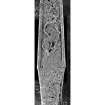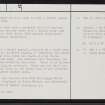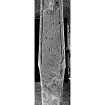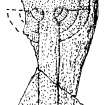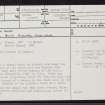Islay, Laggan
Burial Ground (Early Medieval) - (Medieval), Chapel (Early Medieval) - (Medieval), Cross (Medieval), Grave Slab (Medieval)
Site Name Islay, Laggan
Classification Burial Ground (Early Medieval) - (Medieval), Chapel (Early Medieval) - (Medieval), Cross (Medieval), Grave Slab (Medieval)
Canmore ID 37297
Site Number NR25NE 1
NGR NR 29420 55880
Datum OSGB36 - NGR
Permalink http://canmore.org.uk/site/37297
- Council Argyll And Bute
- Parish Killarow And Kilmeny
- Former Region Strathclyde
- Former District Argyll And Bute
- Former County Argyll
NR25NE 1 2942 5588
(NR 2942 5588). Chapel (NR) (In Ruins) Burial Ground (NR)
OS 6" map (1900)
The remains of a chapel which so closely overhangs the stream that part of the south wall has already been washed away. Only very little remains of the walls, but it measures internally 24 1/2ft by 10ft. There are traces of an altar projecting about 4ft from the east wall and there are traces of a recess in the south wall in the place usually devoted to the piscina. There is a small enclosure round the chapel and some uncut stones, which, from their relative positions and orientation appear to be sepulchral.
R C Graham 1895
'St Columbus his church in Laggan.'
M Martin 1934
The burial ground was last used to bury a sailor washed ashore about 1840. From this site have come a possibly 9th-11th century slab bearing an incised cross with a double ring; and a possibly late 15th- early 16th century cross-shaft bearing foliaceous decoration.
W D Lamont 1972.
Field Visit (August 1974)
This site is gradually being eroded by the River Laggan and nothing now remains of the chapel, dedicated to St Columba, that was recorded by Graham in 1895. It measured about 7.5m by 3m internally and incorporated 'traces of an altar projecting about four feet (1.3m) from the east wall'. The S portion of the burial-ground, too, has disappeared, the surviving portion comprising a D-shaped enclosure measuring about 25m from E to W by 6.7m transversely within a bank some 1.8m in width and 1.5m in height. A few plain grave-markers are visible.
The following stones are in the Museum of Islay Life, Port Charlotte. Numbers 1 and 3 were discovered in the eroded river-bank by Mr R Hodkinson, Bowmore, in 1966 and 1964 respectively. Number 2 was removed in 1883 from Laggan to the grounds of Kildalton House, where it remained until 1977.
Early Christian
(1) [Canmore ID 318493] Slab of flaggy siltstone, probably derived from the Torridonian rocks of Islay. It is broken across, and the edges are damaged so that it is uncertain whether they were originally dressed. It now measures 1.06m in length by about 0.35m in maximum width, and bears an incised outline ringed cross with rounded armpits and an elongated upper arm. The cross-head has a broad triple-beaded ring, perhaps intended as two concentric rings, whose outer arc encloses the surviving side-arm. (Lamont, 1968).
Medieval
(2) Greater part of a tapered slab, 1.84m long; it is much worn, and lacks both the upper and lower left corners. Within a border of nail-head between two roll-mouldings, there is at the top a niche containing two figures Pembracing, followed by a sword flanked on the left by an animal and a plant-scroll. At the foot is a panel which may have been inscribed. (Graham, 1895), 14th-early 16th century.
(3) Lower part of the shaft of a free-standing cross, 1.02m high including a tapered 0.41m butt. The shaft, which has roll-moulded angles, tapers in width from 0.19m at the junction with the butt to 0.13m, and has a uniform thickness of 45mm. On the front is the lower part of the figure of the Crucified Saviour, suspended on a cross raguly, while on the
back there is an undulating plant-stem rising from the tail of an animal and incorporating holly-leaves. (Lamont 1968; Steer and Bannerman 1977). Probably Loch Sween school, 14th early 16th century.
RCAHMS 1984, visited August 1974.
Field Visit (3 July 1978)
The remains of a burial ground, situated on a level area above a bend in the River Laggan. It comprises the northern half of an oval mound now 29.0m E-W by 12.0m overall and 0.9m high; the southern half including the chapel has been eroded by the river. There is no evidence of any walling or entrance. There are two small upright earthfast slabs in the south side of the interior, these may be grave marker slabs.
A cross shaft and incised slab from the Laggan River burial is displayed in Islay Museum; are presumably those described by Lamont.
Surveyed at 1:10 000.
Visited by OS (TRG) 3 July 1978
Measured Survey (1982)
RCAHMS prepared a measured drawing of the Early Christian cross-marked stone from Laggan at 1:10 in 1982. The ink drawing of both fragments was published at a reduced scale of 1:15 (RCAHMS 1984, 224A).












